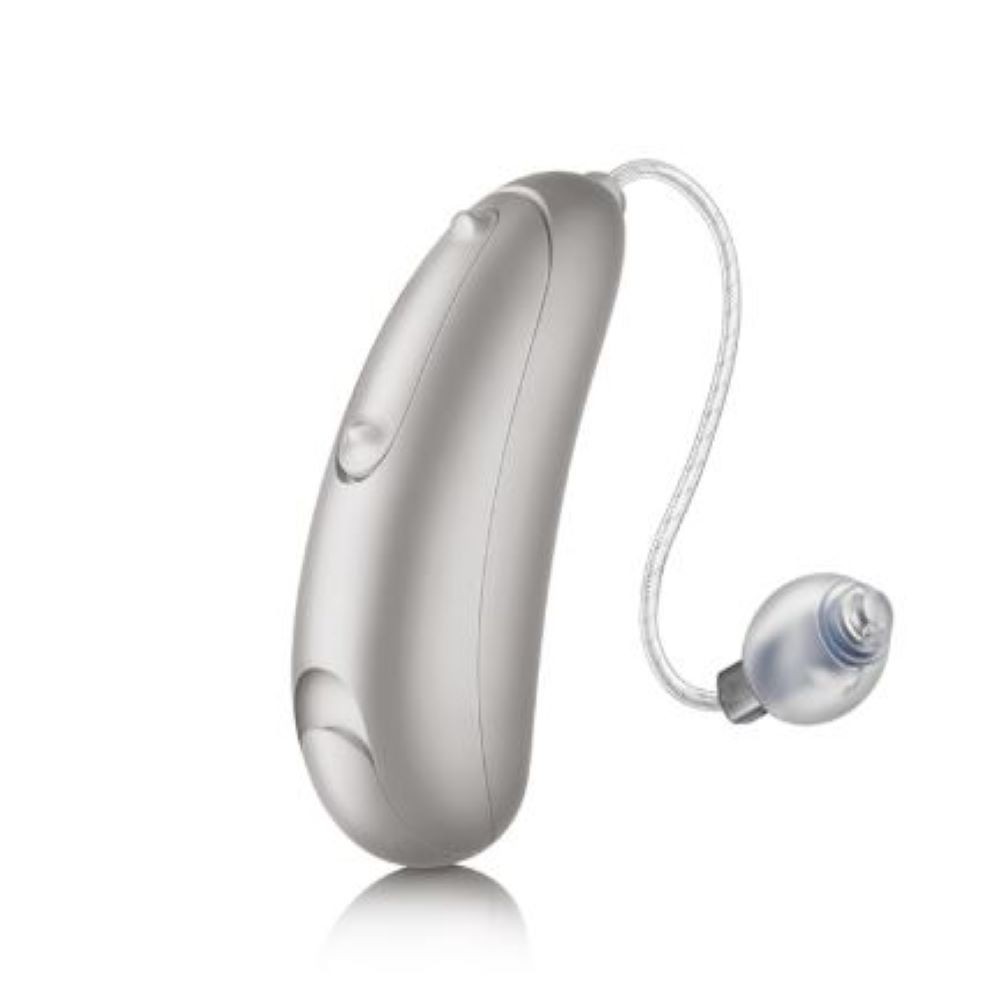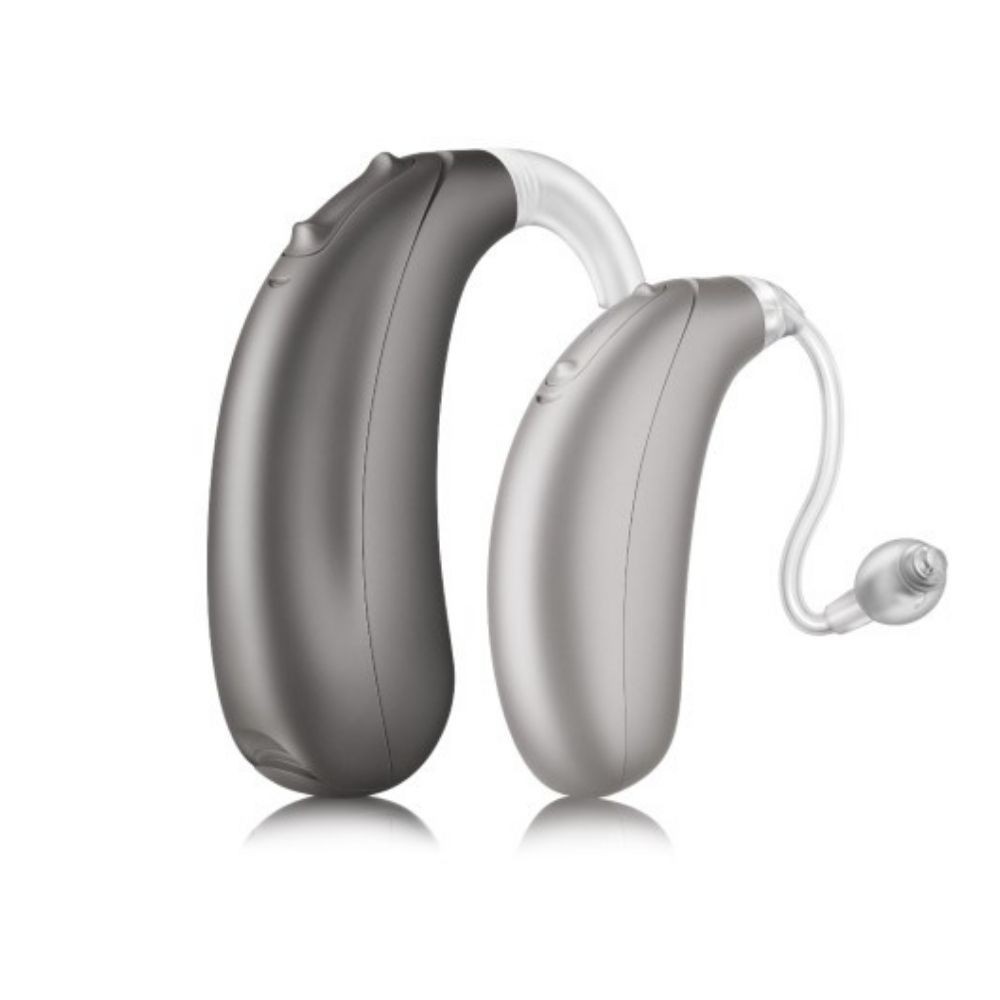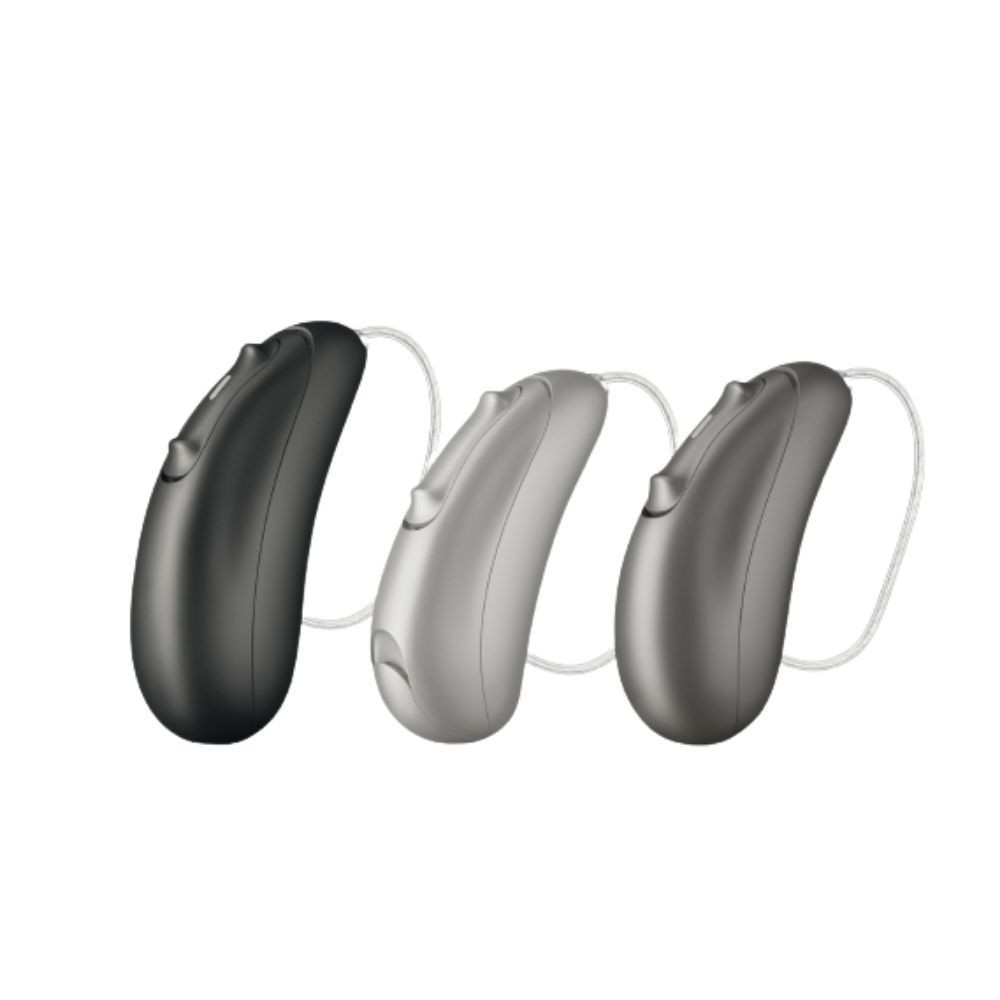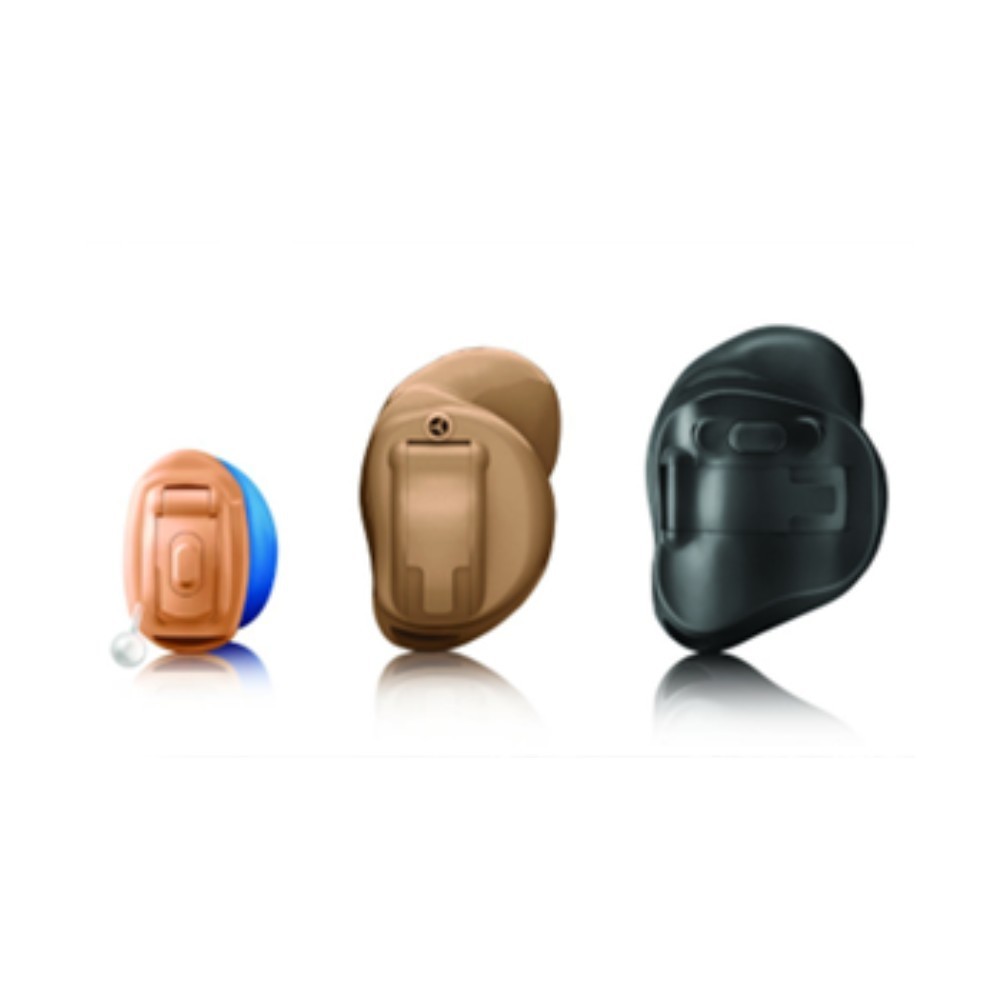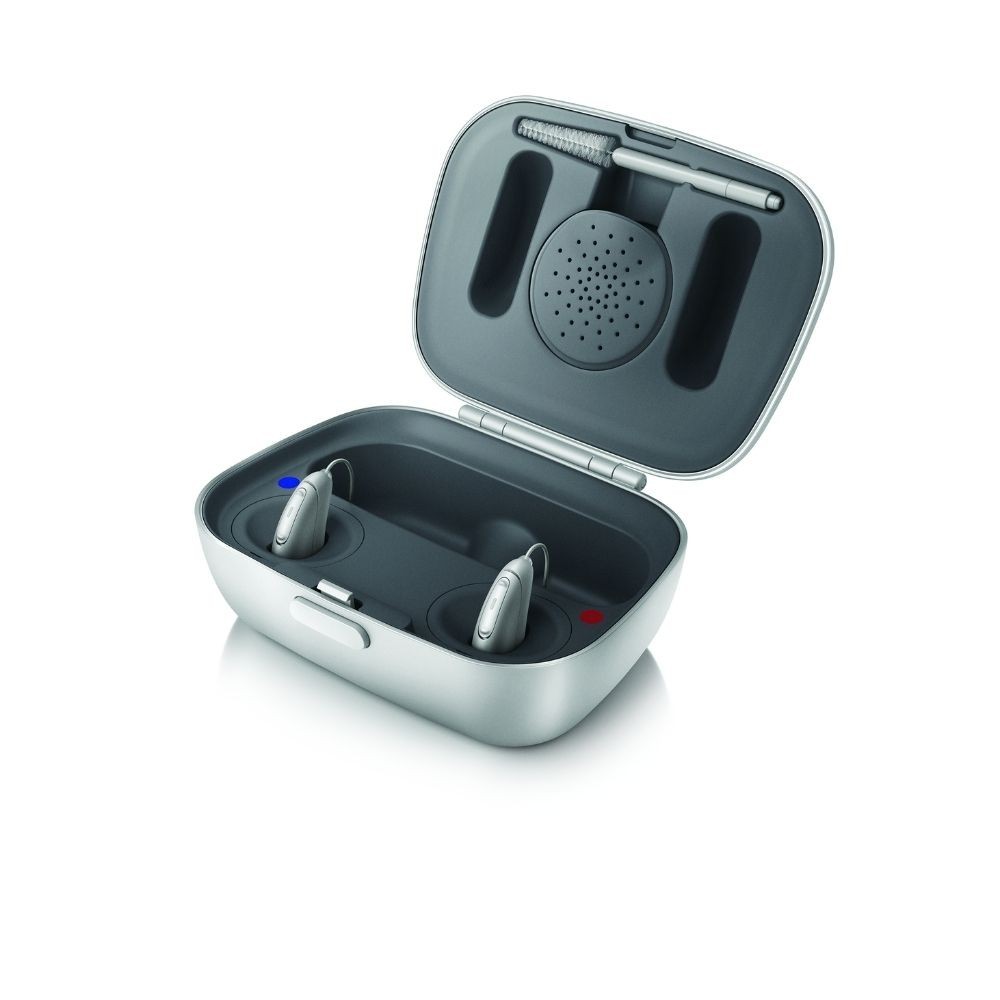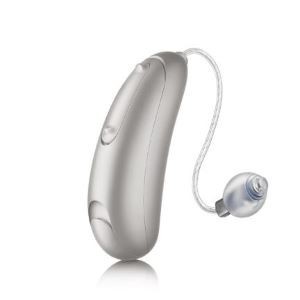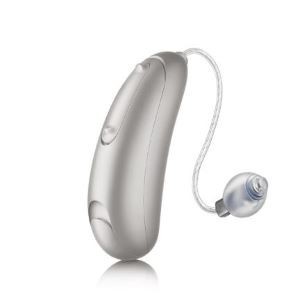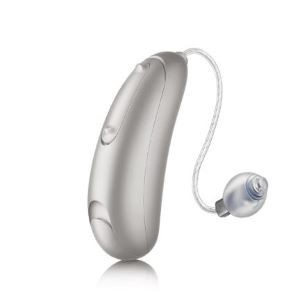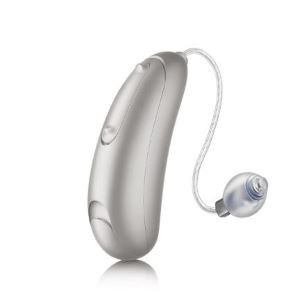Behind the Ear & In the Ear
Fitting Styles: RIC, BTE, CIC, ITC
Warranty: 5 Years
Charger: Rechargeable version at no extra cost

What's included in our hearing aid prices?
Details & Features
Unitron Blu 5 Hearing Aids & Unitron Insera B 5 Hearing aids Overview
November 2022 Update: Unitron introduce the Insera B to the Blu family. Including two non-wireless and one wireless In Ear hearing aids.
January 2022 Update: Unitron introduces their BTE Stride Family to the Blu hearing aid range. Including the Stride B-UP - combining Ultra Power with direct connectivity, telecoil and traditional 675 battery. The Stride B-PR offers lithium-ion rechargeable BTE with direct connectivity.
Introducing the Unitron Blu 5 hearing aids
Launched in April 2021, the Unitron Blu 5 hearing aids are the mid-technical specification of the range. Offering next-generation sound, along with technology that has evolved with consumer's ever-changing needs. The result is advanced personalisation, flexibility, and adaptable technology for a more tailored hearing experience.
View all the Unitron Blu features available and the highest specification - Unitron Blu 9 - here
Main features of Unitron Blu 5 hearing aids:
- The technology: Includes Sonova's powerful PRISM chip (Processing Real-Time Intelligent Sound Management) and new Integra OS signal processing system. These are created to give your hearing a boost in all real-life hearing scenarios.
- The adaptability: Boost your clarity and listening comfort with this hearing aid range - along with the Remote Plus app. Choose from six fixed programs to further adjust and enhance your speech and focus and alter your noise reduction.
- The Connectivity: This is a Made for Any Phone, which means it's compatible with both Apple/iOS and Android devices - as well as all Unitron's Bluetooth accessories. Connect and interact with two simultaneous devices and eight to be paired at the same time. In addition, the new tap control feature also gives you more freedom to access virtual assistant services, take hands-free calls, and pause/play audio with just a tap of your ear*
- The Shape: The new Moxi shape now offers you, as a wearer, a more comfortable fit. There are also extras like more consumer-friendly in-app reminders and handy 'how to' memos. This is designed to be better educated about Unitron's devices and this specific hearing aid range.
- The Styles: This RIC hearing aid range includes two rechargeable options.
Unitron Blu 5 hearing aid styles
Unitron Blu 5 Behind Ear hearing aid styles:
- Moxi B R: Lithium-Ion rechargeable battery, push-button, Bluetooth connectivity.
- Moxi B R T: Lithium-Ion rechargeable battery, push-button, Bluetooth connectivity, Telecoil.
- Moxi B 312: 312 battery, push-button, Bluetooth connectivity.
- Stride B-UP: 675 battery, push-button, Bluetooth connectivity, Telecoil.
- Stride B-PR: Lithium-Ion rechargeable battery, push-button, Bluetooth connectivity.
Unitron Insera B 5 Hearing Aids (In Ear hearing aid styles):
- Insera B 312: An In the Canal wireless hearing aid (ITC) with a 312 battery, push button, and Made for All Bluetooth connectivity.
- Insera B 312 NW O: An In the Canal hearing aid (ITC) with a 312 battery, push button, and telecoil.
- Insera B 10 NW O: A Completely in the Canal (CIC) with a 10 battery, push button, and telecoil.
Unitron Blu 5 hearing aid's Flex-Upgrade
Unitron Blu 5 is available to upgrade - this means that if your hearing does change you have the flexibility to opt for an upgrade. This switches your current performance level to a higher level that would suit your new hearing needs.
Unitron Blu 5 hearing aid's Flex-Trial
Offering you a real-life review of the device and technology. Speak to one of our audiologists to find out more information or to book your trial today.
Comparing the Unitron Blu 5 with the 9 - What main features do you lose?
- Three fewer listening environments.
- It doesn't include the AutoFocus 360 feature, which is used to enhance speech from all directions, even in the most challenging of listening soundscapes.
Want to know more about the Unitron Blu 5 & Unitron Insera B 5 hearing aids?
You can find out more information by reading our range page here
Or alternatively, you can call us free on 0800 567 7621 to speak with one of our audiologists about this digital hearing aid range.
►Click here to go to the top of the page
Other performance levels in this range:
**Please note, there will be an additional surcharge of £125 if we are pairing a single hearing aid with an existing aid bought from another company where we are taking over the aftercare responsibilities and looking after both hearing aids**
*The tap control feature is only available in the rechargeable models (Moxi B R and Moxi B R T)
Paul Harrison is an audiology expert at Hearing Aid UK, with over 20 years of audiology experience and a member of the British Society of Hearing Aid Audiologists Council (BSHAA) between 2015 - 2020.
Explore Unitron Blu 5 hearing aid prices, video and brochure below
Watch the Unitron Blu 5 Hearing Aid Video Below
Have any questions?
Here, at Hearing Aid UK, we offer a wide range of hearing aids available on the market - keeping up to date with the best and latest hearing aid technology.
We can support your hearing healthcare in clinic or in the comfort of your own home and with nationwide coverage, we will have an audiologist near you.
Whatever your hearing loss level, budget, or style our audiologists can help you find the perfect hearing solution for you.
Call us free for support and advice on 0800 567 7621
Our specialist service includes:
Do not spend hundreds of pounds without getting a second opinion from us.
Please call us on 0800 567 7621
 Not only are the prices great, but the service is fantastic! Many thanks to your team.
Not only are the prices great, but the service is fantastic! Many thanks to your team.Other pages you might find useful
What's included in our hearing aid prices?
If you are looking at this page then it is likely that an audiologist has suggested that you purchase this particular hearing aid, so is this the best model for you?
In general, any audiologist will always recommend to you the model that best suits your needs. Here is a useful checklist to make sure that is the case.
- Audiologist level of knowledge: The audiologist you have seen will hopefully have a wide knowledge of all available hearing aids, however, some will only be familiar with a small number of brands and therefore may not really be in a position to know which model is the best for you. It is OK to challenge their recommendation and ask them to justify why this particular brand is the one for you.
- Do research: Read about the hearing aid that was recommended. Does it seem like it will suit your lifestyle? Does it have more or fewer features than you need?
- Be aware of sales targets: Many high street retailers have specific tie-ins to a particular manufacturer/brand. The hearing aid they have suggested may still be the correct one for you, but do your research so that you know why they might have recommended it.
If in doubt, feel free to give us a call. That's what we're here for. In the meantime, read all about our review of the best hearing aids for 2025 here
If you have significant hearing loss in both ears, you should be wearing two hearing aids. Here are the audiological reasons why:
Localisation: The brain decodes information from both ears and compares and contrasts them. By analysing the minuscule time delays as well as the difference in the loudness of each sound reaching the ears, the person is able to accurately locate a sound source. Simply put, if you have better hearing on one side than the other, you can't accurately tell what direction sounds are coming from.
Less amplification is required: A phenomenon known as “binaural summation” means that the hearing aids can be set at a lower and more natural volume setting than if you wore only one hearing aid.
Head shadow effect: High frequencies, the part of your hearing that gives clarity and meaning to speech sounds, cannot bend around your head. Only low frequencies can. Therefore if someone is talking on your unaided side you are likely to hear that they are speaking, but be unable to tell what they have said.
Noise reduction: The brain has its own built-in noise reduction which is only really effective when it is receiving information from both ears. If only one ear is aided, even with the best hearing aid in the world, it will be difficult for you to hear in background noise as your brain is trying to retain all of the sounds (including background noise) rather than filtering it out.
Sound quality: We are designed to hear in stereo. Only hearing from one side sounds a lot less natural to us.
Fancy some further reading on this topic? You can read about why two hearing aids are better than one in our article, hearing aids for both ears, here
For most people, the main benefit of a rechargeable hearing aid is simple convenience. We are used to plugging in our phones and other devices overnight for them to charge up. Here are some other pros and cons:
For anybody with poor dexterity or issues with their fingers, having a rechargeable aid makes a huge difference as normal hearing aid batteries are quite small and some people find them fiddly to change.
One downside is that if you forget to charge your hearing aid, then it is a problem that can't be instantly fixed. For most a 30-minute charge will get you at least two or three hours of hearing, but if you are the type of person who is likely to forget to plug them in regularly then you're probably better off with standard batteries.
Rechargeable aids are also a little bit bigger and are only available in Behind the Ear models.
Finally, just like with a mobile phone, the amount of charge you get on day one is not going to be the same as you get a few years down the line. Be sure to ask what the policy is with the manufacturer warranty when it comes to replacing the battery.
Looking for more information on rechargeable hearing aids? Read our dedicated page on the topic here
For most people, the answer is yes. But it's never that simple.
The majority of hearing problems affect the high frequencies a lot more than the low ones. Therefore open fitting hearing aids sound a lot more natural and ones that block your ears up can make your own voice sound like you are talking with your head in a bucket. Therefore in-ear aids tend to be less natural.
However the true answer is we can't tell until we have had a look in your ears to assess the size of your ear canal, and until we have tested your hearing to see which frequencies are being affected.
People with wider ear canals tend to have more flexibility, also there are open fitting modular CIC hearing aids now that do not block your ears.
There is also the age old rule to consider, that a hearing aid will not help you if it's sat in the drawer gathering dust. If the only hearing aid you would be happy wearing is one that people can't see, then that's what you should get.
Most people can adapt to any type of hearing aid, as long as they know what to expect. Have an honest conversation with your audiologist as to what your needs are.
Generally speaking, six or more. Unless it's none at all.
The number of channels a hearing aid has is often a simplistic way an audiologist will use to explain why one hearing aid is better than another, but channels are complex and it is really not that straightforward. Here are some reasons why:
Hearing aids amplify sounds of different frequencies by different amounts. Most people have lost more high frequencies than low and therefore need more amplification in the high frequencies. The range of sounds you hear are split into frequency bands or channels and the hearing aids are set to provide the right amount of hearing at each frequency level.
Less than six channels and this cannot be done with much accuracy, so six is the magic number. However, a six channel aid is typically very basic with few other features and is suitable only for hearing a single speaker in a quiet room. The number of channels is not what you should be looking at, it's more the rest of the technology that comes with them.
As a final note, different manufacturers have different approaches. One method is not necessarily better than any other. For example, some manufacturers have as many as 64 channels in their top aids. Most tend to have between 17 and 20. One manufacturer has no channels at all.
Hearing aids are easily lost, misplaced or damaged and typically are one of the most expensive personal possessions an individual can own. We offer hearing aid warranty coverage for £80 per year per aid. Find out more about this service we provide here
Other Models
Ask the Experts
6 Morton Lane
Walkwood
Redditch
Worcestershire
B97 5QA
Latest Launch
When we refer to a product as 'Latest Launch', we mean it is the latest to be released on the market.
New
When we refer to a product as 'New', we mean that the product is the newest hearing aid model on the market.
When we refer to a product as 'Superseded', we mean that there is a newer range available which replaces and improves on this product.
Older Model
When we refer to a product as an 'Older Model', we mean that it is has been superseded by at least two more recent hearing aid ranges.


